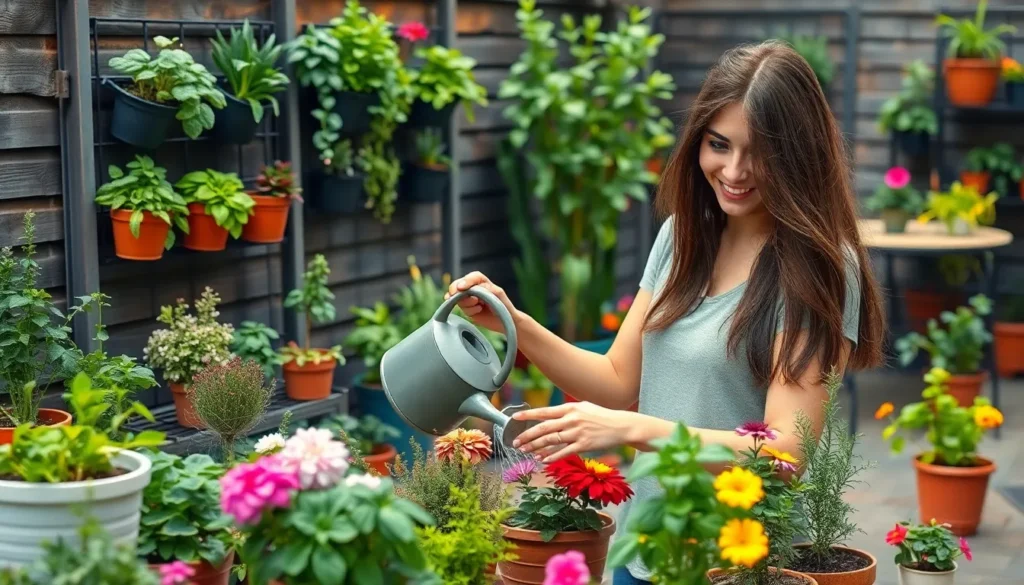We all dream of transforming our outdoor spaces into stunning sanctuaries that reflect our personal style while boosting our home’s curb appeal. Whether you’re working with a sprawling backyard or a compact urban plot, the right house garden ideas can turn any space into a breathtaking retreat that’ll make your neighbors green with envy.
From vertical gardens that maximize small spaces to Mediterranean-inspired courtyards that transport you to Tuscany, today’s gardening trends offer endless possibilities for every budget and skill level. We’ve discovered that the most successful gardens blend functionality with beauty – creating spaces where you can grow fresh herbs, entertain guests, and find peaceful moments away from daily stress.
Ready to discover garden design ideas that’ll transform your outdoor space from ordinary to extraordinary? We’re about to share proven strategies and creative answers that’ll help you create the garden of your dreams, regardless of your experience level or space constraints.
Creative Container Garden Ideas for Small Spaces
Container gardening transforms cramped patios and tiny balconies into lush green retreats. We’ve discovered countless ways to maximize growing space while creating stunning visual displays that rival traditional garden beds.
Vertical Planter Arrangements
Vertical planters multiply our growing capacity by utilizing wall space and creating dramatic living art installations. Wall mounted pocket planters accommodate herbs like basil, thyme, and oregano while taking up minimal floor space. Stacked planter towers work perfectly for strawberries, lettuce, and cascading flowers like petunias.
Ladder style plant stands provide multiple levels for different sized containers while maintaining easy access for watering and harvesting. Wooden pallets converted into vertical gardens create rustic charm while housing dozens of small plants in individual pockets. Trellis systems support climbing vegetables such as peas, beans, and cherry tomatoes that grow upward rather than outward.
Repurposed Household Items as Planters
Repurposed containers add personality to our gardens while reducing waste and saving money on expensive planters. Old rain boots become whimsical planters for succulents and small flowering plants that delight children and visitors alike. Vintage colanders provide excellent drainage for herbs while adding farmhouse style to kitchen windowsills.
Wooden crates stacked at different angles create tiered displays perfect for seasonal flowers and vegetable starts. Tin cans wrapped in burlap or painted with chalkboard paint house individual herb plants while doubling as garden markers. Large yogurt containers work exceptionally well for starting seedlings before transplanting to larger spaces.
Dresser drawers lined with industry fabric become unique raised bed alternatives for shallow rooted crops like lettuce and radishes. Old wheelbarrows serve as mobile garden beds that we can relocate to follow sunlight throughout the day.
Hanging Garden Answers
Hanging gardens maximize vertical space while creating eye catching displays at multiple height levels throughout our outdoor areas. Macrame plant hangers showcase trailing plants like pothos, spider plants, and string of pearls that cascade beautifully from porches and pergolas. Ceiling mounted pulley systems allow us to lower hanging baskets for easy maintenance before raising them back to optimal growing positions.
Wire hanging baskets lined with coconut fiber work perfectly for strawberries and cherry tomatoes that benefit from excellent drainage and air circulation. Upside down planters designed specifically for tomatoes and peppers save ground space while producing impressive yields throughout the growing season.
Multiple tiered hanging systems create living curtains using lightweight containers filled with herbs, flowers, and trailing vegetables. Shepherd’s hooks positioned strategically around patios support various hanging containers while allowing flexibility to rearrange displays as plants grow and seasons change.
Budget-Friendly DIY House Garden Projects
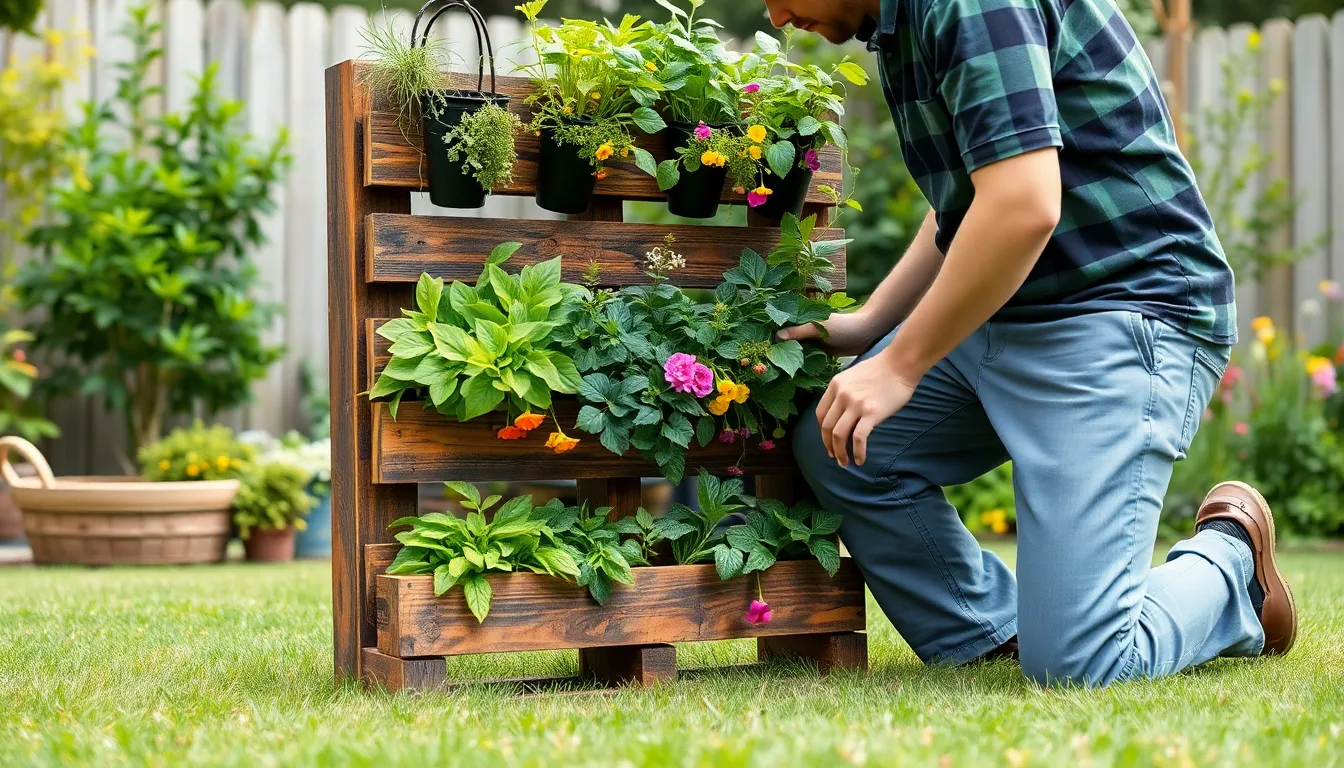
Building stunning garden features doesn’t require expensive materials or professional contractors. We can create beautiful outdoor spaces using affordable supplies and simple techniques that deliver impressive results.
Pallet Garden Constructions
Pallet planters transform discarded shipping materials into functional growing spaces for herbs, flowers, and vegetables. We recommend sanding pallets smooth and applying food-safe wood sealant before planting to ensure durability and plant safety.
Vertical pallet gardens maximize growing space by standing pallets upright and filling slats with soil and plants. These structures work perfectly for strawberries, lettuce, and cascading flowers that create living walls.
Pallet trellises support climbing plants like peas, beans, and morning glories with minimal construction effort. We simply position pallets behind planted areas and secure them with stakes for instant vertical growing support.
Pallet pathways create defined garden walkways by laying pallets flat and covering them with gravel or wood chips. This project requires only basic tools and transforms muddy garden paths into attractive, functional routes.
Seed Starting Techniques
Seed trays filled with quality seed starting mix provide the foundation for successful indoor germination. We use 72-cell trays that allow individual plant development while maximizing growing space efficiency.
Grow lights ensure adequate illumination when natural sunlight isn’t sufficient for seed development. LED grow lights positioned 6-8 inches above seedlings provide optimal light spectrum without generating excessive heat.
Temperature control maintains consistent soil warmth between 65-75°F for most vegetable and flower seeds. We use heat mats under seed trays to achieve uniform germination temperatures throughout the growing medium.
Watering techniques keep soil consistently moist without waterlogging delicate seedlings. Bottom watering through drainage trays prevents soil disturbance while ensuring roots receive adequate moisture.
Homemade Compost Systems
Three bin systems create continuous compost production using wooden pallets or wire fencing to form compartments. We fill the first bin with fresh materials, turn contents into the second bin for active decomposition, and harvest finished compost from the third bin.
Tumbler composters accelerate decomposition through regular turning and improved aeration. These enclosed systems prevent pest access while maintaining optimal moisture and temperature conditions for rapid organic matter breakdown.
Green and brown material ratios balance nitrogen-rich kitchen scraps with carbon-heavy yard waste for efficient decomposition. We maintain approximately 3:1 brown to green material ratios to prevent odors and promote healthy microbial activity.
Moisture management keeps compost piles damp like a wrung-out sponge without creating waterlogged conditions. Regular monitoring and occasional water additions ensure optimal decomposition environments throughout seasonal weather changes.
Indoor House Garden Ideas for Year-Round Growing
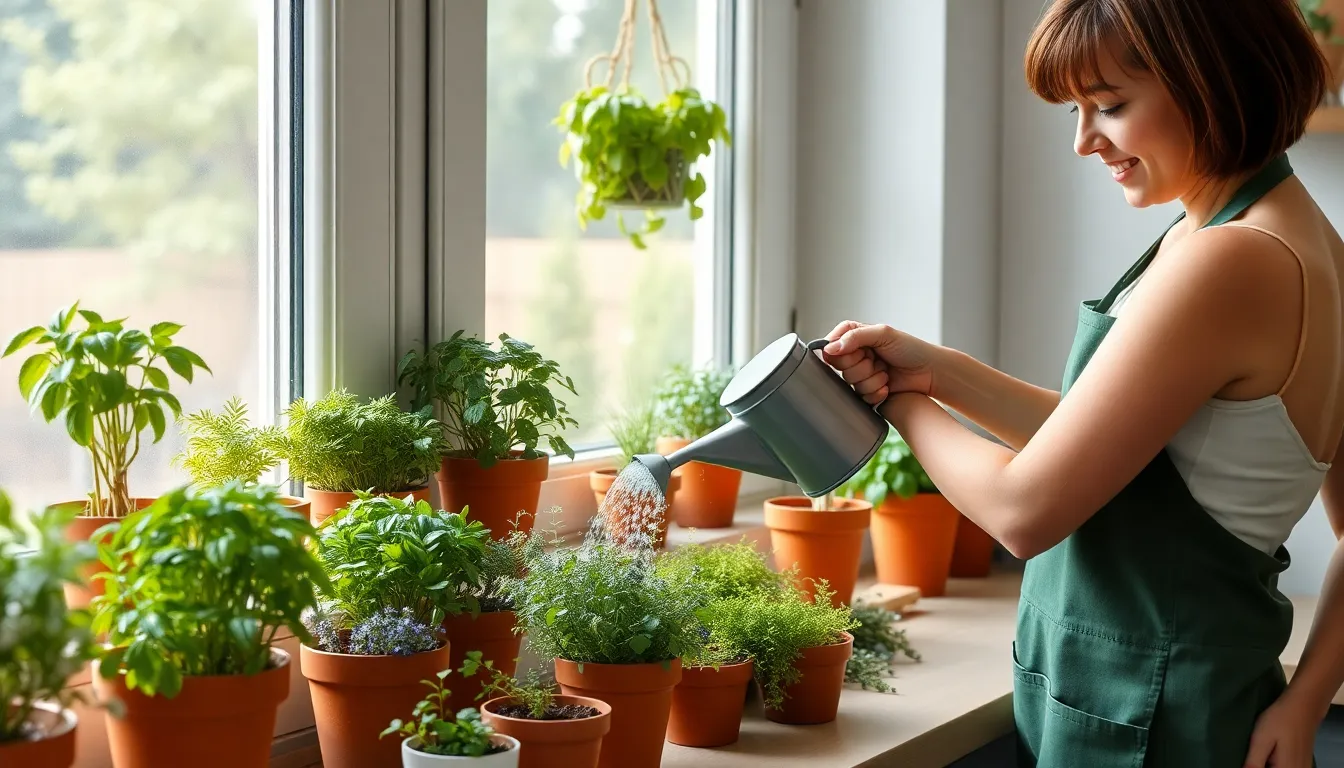
Growing fresh food and herbs indoors ensures we’ll have continuous harvests regardless of weather conditions or seasonal limitations. Indoor gardening opens up exciting possibilities for year-round cultivation that keeps our kitchens stocked with fresh ingredients.
Herb Garden Kitchen Setups
Creating an indoor herb garden transforms our kitchen into a culinary paradise where fresh flavors are always within reach. We’ll want to select herbs like basil, parsley, cilantro, chives, oregano, mint, and rosemary since they adapt easily to indoor conditions and require minimal maintenance.
Setting up drainage becomes crucial for herb garden success. We need pots with adequate drainage holes to prevent waterlogged soil that can kill our plants. Watering herbs in the sink eliminates mess while ensuring excess water drains properly.
Maintaining consistent moisture levels helps herbs thrive indoors. We should check soil moisture regularly and water when the top inch feels dry. Regular trimming encourages new growth and provides us with fresh herbs for cooking throughout the year.
Houseplant Display Arrangements
Arranging houseplants creates visual appeal while maximizing growing space for our indoor gardens. Terra cotta pots work exceptionally well for regulating soil moisture naturally while adding rustic charm to our displays.
Planning drainage systems prevents water damage to our floors and furniture. We can place saucers under pots or water plants directly in the sink to catch excess drainage. Good drainage holes in containers remain essential for healthy plant growth.
Grouping plants with similar water and light requirements makes maintenance easier. We might arrange sun-loving herbs near south-facing windows while placing shade-tolerant houseplants in dimmer corners of our kitchen or living spaces.
Hydroponic Growing Systems
Hydroponic systems deliver precise nutrient control that often produces faster growth than traditional soil gardening. We can grow various plants including herbs and vegetables using these space-efficient indoor methods.
Controlling nutrient delivery becomes the primary advantage of hydroponic growing. We mix exact nutrient answers that feed plants directly through their root systems, eliminating guesswork about soil fertility.
Setting up hydroponic systems requires more complexity than soil-based gardening but offers greater control over growing conditions. We’ll need to invest in proper lighting, nutrient answers, and pH monitoring equipment to achieve optimal results with our hydroponic indoor gardens.
Seasonal House Garden Planning Strategies
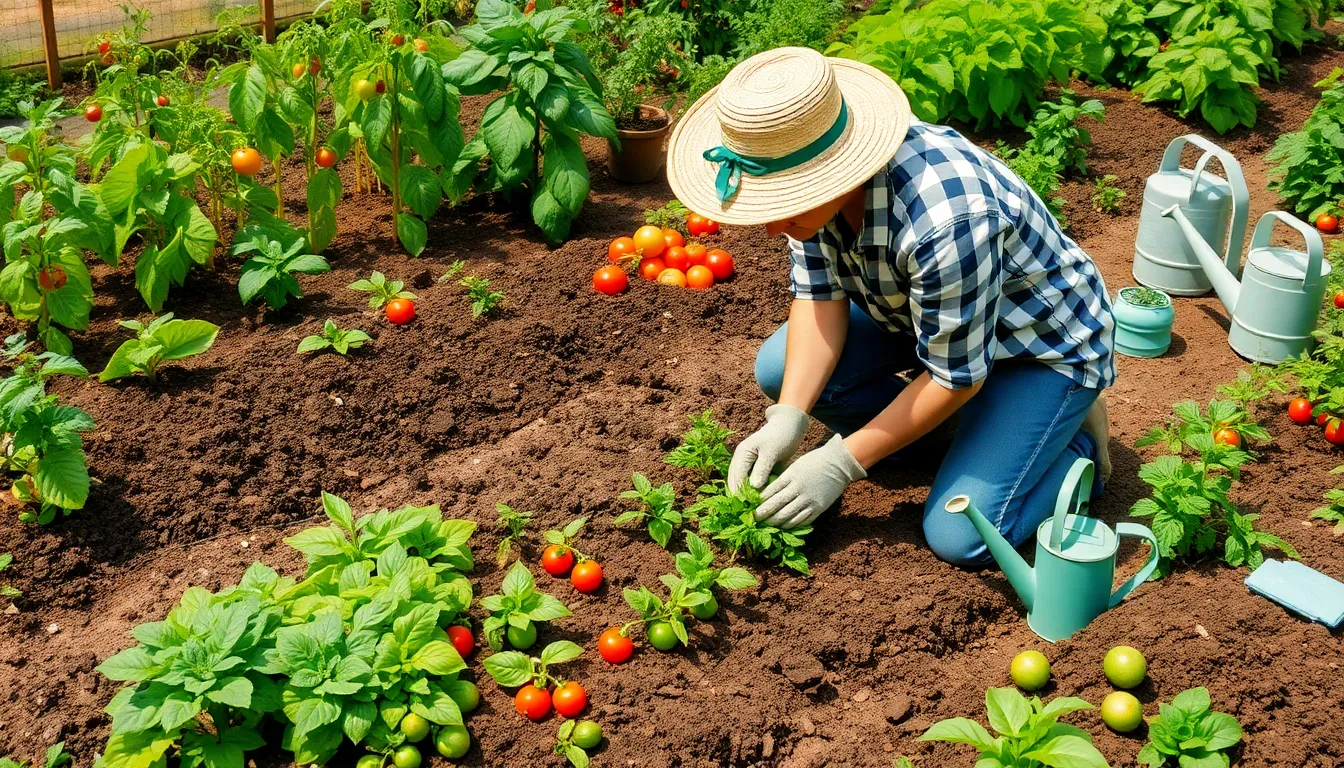
Strategic garden planning throughout the year ensures we maximize our harvest potential while maintaining healthy, thriving plants. We’ll transform our outdoor spaces by implementing proven seasonal approaches that work with nature’s rhythm.
Spring Planting Schedules
Early season preparation sets the foundation for our garden’s success throughout the growing year. We start planting cool-season crops like lettuce and spinach as soon as the soil can be worked, typically when temperatures consistently reach 40-50°F during the day.
Soil enrichment becomes our priority before any planting begins. We add compost or manure to boost nutrient levels and improve soil structure for optimal root development. This preparation step increases our chances of vigorous plant growth by up to 40% compared to unamended soil.
Variety selection requires careful consideration of both fast-growing and slower-maturing plants. We choose quick producers like radishes and arugula alongside longer-season crops such as tomatoes and peppers. This strategic approach ensures continuous harvests from early spring through late fall.
Temperature monitoring guides our planting timeline effectively. We track soil temperatures using a simple thermometer, planting warm-season crops only after soil reaches 60°F consistently. Cool-season vegetables thrive in 45-65°F soil conditions and can tolerate light frosts.
Summer Maintenance Routines
Water management becomes critical during peak growing season when plants face heat stress and increased evaporation. We carry out drip irrigation systems to deliver water directly to root zones while conserving up to 50% more water than traditional sprinkler methods.
Mulching applications protect our plants from temperature extremes and moisture loss. We apply 2-3 inch layers of organic mulch around plants to retain soil moisture and suppress weed growth. Wood chips, straw, and shredded leaves work exceptionally well for this purpose.
Pest monitoring requires regular inspection schedules to catch problems before they become severe. We check plants weekly for signs of insect damage, fungal infections, and nutrient deficiencies. Early detection allows us to address issues using targeted organic treatments rather than broad-spectrum chemicals.
Heat protection strategies help sensitive plants survive extreme summer temperatures. We use shade cloth with 30-50% coverage during heat waves and ensure adequate air circulation around plants. Container gardens benefit from moving to partially shaded locations during the hottest part of the day.
Fall Harvest Preparations
Crop assessment determines which summer plants can continue producing into cooler months. We evaluate the health of remaining tomatoes, peppers, and herbs to decide whether they’ll survive first frost or need harvesting immediately. Healthy plants often produce well into October with proper protection.
Cover crop planning enriches our soil for next year’s growing season while protecting bare garden beds. We plant cover crops like buckwheat or clover in empty spaces to add nitrogen and organic matter. These crops prevent soil erosion and suppress weeds during winter months.
Frost protection extends our harvest season by several weeks with simple techniques. We use row covers made from lightweight fabric to protect sensitive plants when temperatures drop below 35°F. Cold frames and hoop tunnels create microclimates that can add 4-6 weeks to our growing season.
Seed collection preserves our best-performing varieties for future planting seasons. We harvest seeds from open-pollinated plants like tomatoes, peppers, and herbs when fruits reach full maturity. Proper drying and storage techniques ensure 85-95% germination rates for next year’s garden.
Low-Maintenance House Garden Solutions
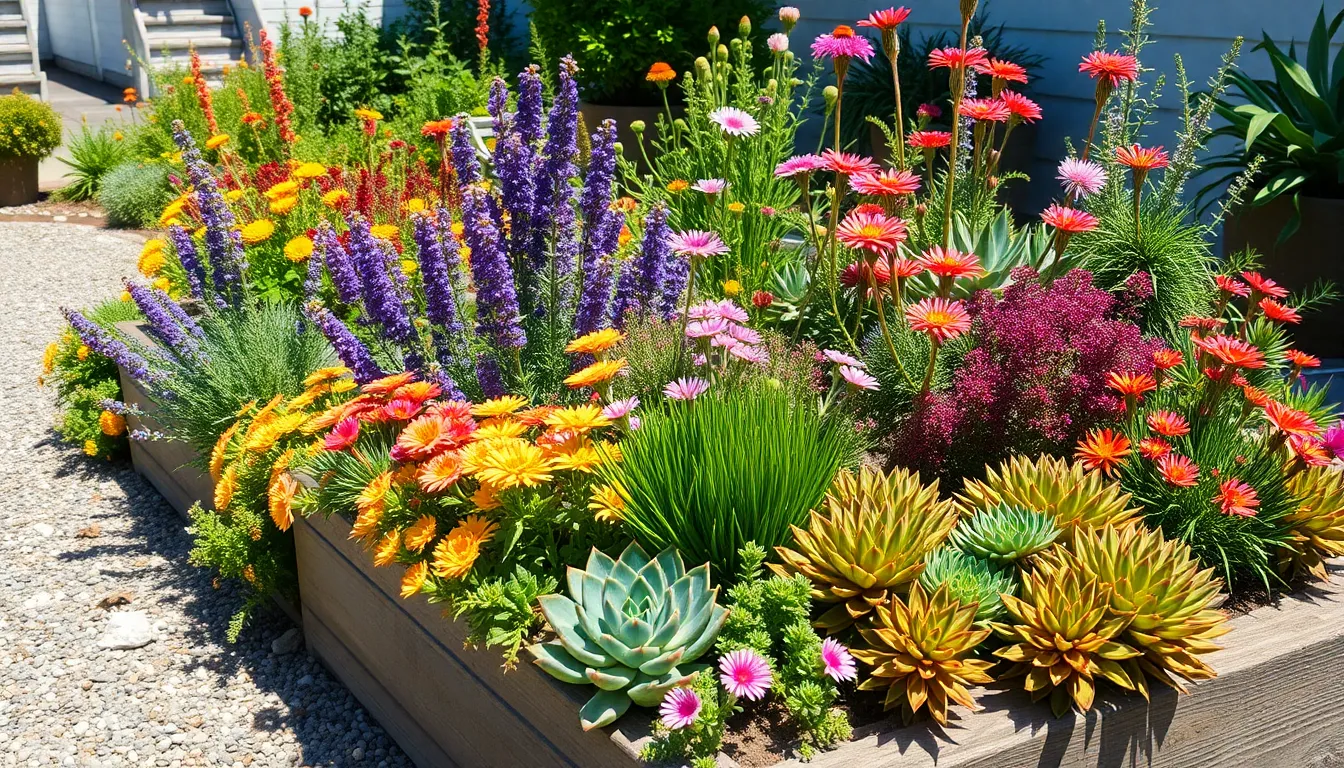
Creating beautiful gardens shouldn’t require endless hours of upkeep. Smart plant choices and efficient systems let us enjoy stunning outdoor spaces with minimal effort.
Drought-Tolerant Plant Selections
Succulents like sedum thrive in challenging conditions while requiring minimal water throughout the growing season. These hardy plants adapt well to poor soil conditions and store water in their fleshy leaves, making them perfect for busy gardeners.
Native shrubs including lavender, yarrow, and blanket flower establish deep root systems that access groundwater naturally. Lavender produces fragrant purple blooms that attract beneficial pollinators while requiring watering only during extreme drought periods. Yarrow spreads to form colorful ground cover that blooms from spring through fall with virtually no maintenance.
Applying mulch around drought tolerant plants helps retain soil moisture and suppress competing weeds. Organic mulches like wood chips break down slowly to improve soil structure while reducing our watering needs by up to 50%.
Ground covers such as creeping thyme and sedum replace traditional grass areas that demand regular mowing and fertilizing. Creeping thyme releases pleasant fragrance when walked on and produces tiny flowers that butterflies love.
Self-Watering Garden Systems
Self-watering containers feature built-in reservoirs that supply consistent moisture to plant roots as needed. These containers reduce watering frequency from daily to weekly while preventing both overwatering and drought stress in our plants.
Window boxes equipped with self-watering mechanisms allow easy seasonal plant rotation without constant monitoring. We can install these systems on sunny windowsills to grow herbs and flowers that enhance our home’s curb appeal year round.
Drip irrigation systems deliver water directly to plant root zones through small emitters and tubing networks. Automated timers control these systems to provide precise watering schedules that conserve water and reduce waste by up to 30% compared to traditional sprinklers.
Installing deep gravel paths throughout our gardens improves drainage while eliminating grass maintenance requirements. Gravel pathways require only occasional raking to maintain their appearance and prevent weed growth.
Native Plant Landscaping
Native plants adapt naturally to local climate conditions and soil types without requiring supplemental fertilizers or pest control treatments. These species evolved in our exact regions over thousands of years, making them incredibly resilient to weather extremes.
Choosing native perennials like catmint, coreopsis, heuchera, and dicentra provides colorful blooms that return each spring without replanting. Catmint produces aromatic foliage and purple flower spikes that bloom continuously from late spring through early fall.
Native plants attract beneficial pollinators and insects that support local network health while reducing pest problems naturally. Birds feed on native plant seeds and berries, creating wildlife habitat that enhances our garden’s natural beauty.
Ground cover alternatives using native species eliminate weekly mowing and reduce fertilizer applications that can harm local waterways. Native sedges and wildflowers create naturalized areas that require only annual cutting to maintain their appearance.
Edible House Garden Design Concepts
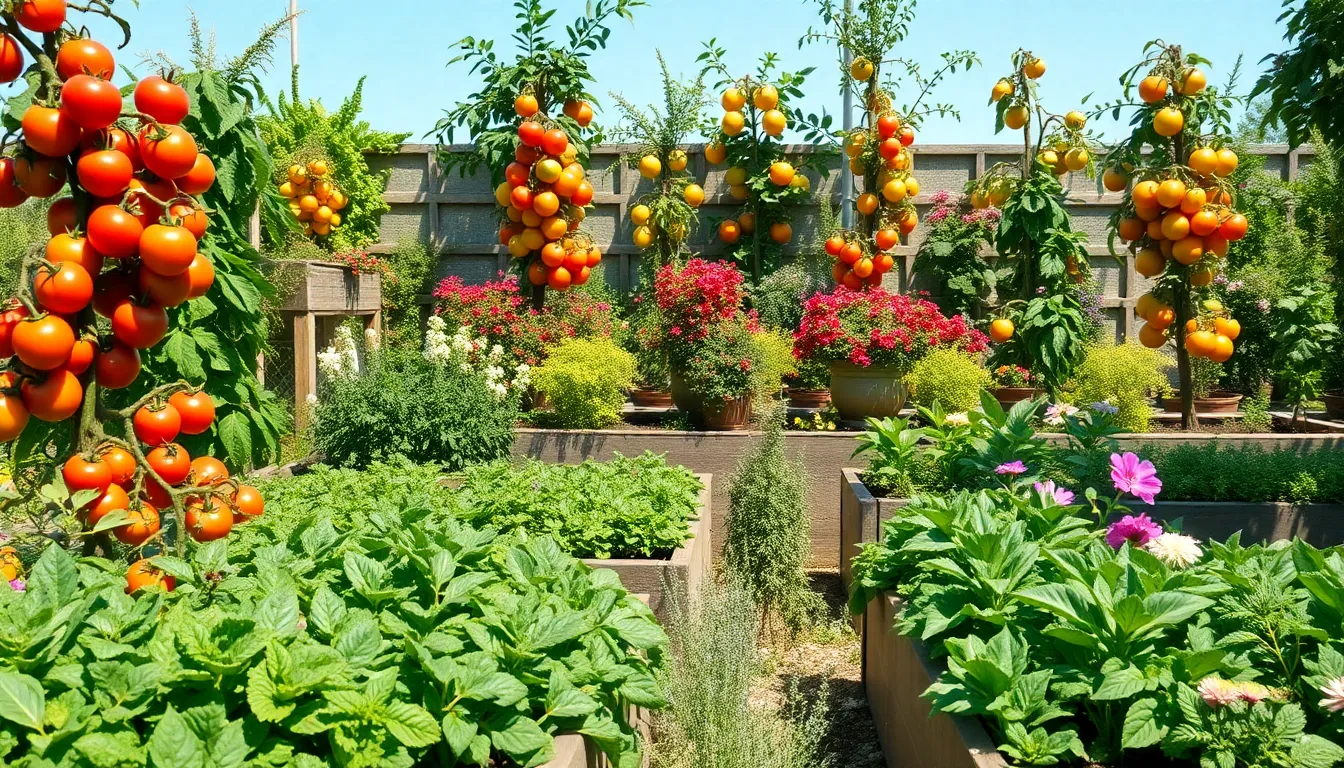
We’re embracing the foodscaping revolution by transforming traditional landscapes into productive edible gardens that satisfy both our aesthetic desires and nutritional needs. Permaculture inspired designs focus on sustainable practices while creating self-sufficient micro-farming spaces that thrive with minimal intervention.
Vegetable Garden Layout Plans
Salsa gardens combine tomatoes, peppers, onions, and herbs to create vibrant growing spaces that deliver fresh ingredients straight from soil to table. We position these complementary plants together since they share similar growing requirements and harvest timing.
Green juice gardens include leafy greens, citrus, and nutrient dense fruits that transform our morning routines into healthy rituals. Kale, spinach, and Swiss chard occupy the shadier sections while citrus trees anchor sunny corners.
Mixed vegetable beds alternate root crops like carrots with sprawling zucchini and compact lettuce varieties to maximize space efficiency. We interplant herbs throughout these beds to create natural pest deterrents and flavor enhancers.
Square foot gardening divides growing areas into manageable sections that simplify planting, weeding, and harvesting tasks. Each square accommodates exact plant quantities based on mature size requirements.
Fruit Tree Integration Ideas
Orchard layouts position multiple fruit trees in deliberate patterns that maximize sunlight exposure while creating natural windbreaks and privacy screens. We space dwarf varieties 6-8 feet apart and standard trees 15-20 feet apart for optimal growth.
Espalier systems train fruit trees against walls or trellises to create living art installations that produce abundant harvests in minimal space. Apple, pear, and citrus trees adapt particularly well to these flat growing techniques.
Fruit tree guilds surround each tree with beneficial companion plants including nitrogen fixing herbs, pest repelling flowers, and ground covering berries. These integrated systems create self-sustaining ecosystems that reduce maintenance requirements.
Companion Planting Strategies
Protective pairings use marigolds with tomatoes to deter harmful nematodes while basil enhances tomato flavor and repels flying insects. We plant these combinations throughout our edible gardens to create natural pest management systems.
Shading strategies position tall plants like sunflowers to protect heat sensitive crops like lettuce during scorching summer months. Corn stalks provide natural trellises for climbing beans while offering afternoon shade.
Beneficial insect attractors include lavender and dill flowers that draw pollinators and predatory insects to our growing spaces. We scatter these plants throughout vegetable beds to maintain ecological balance and improve harvest yields.
Decorative House Garden Enhancement Ideas

We’ve explored functional growing spaces, and now it’s time to focus on the decorative elements that transform ordinary gardens into stunning outdoor sanctuaries. These enhancement ideas combine visual appeal with practical benefits to create spaces that truly reflect your personal style.
Garden Pathway Designs
Gravel pathways offer the perfect balance of simplicity and elegance for both small and large yards. These low maintenance options require minimal upkeep while providing excellent drainage and a satisfying crunch underfoot. Pea gravel pathways create a more relaxed, natural feel that complements cottage garden styles and informal industry designs.
Keystone pathways deliver a sophisticated look when combined with metal edging for clean, defined borders. Sharp edged elements like metal strips create that polished appearance we’re after while maintaining functionality for easy maintenance. Linear design elements help guide the eye through your garden space and create visual organization.
Natural overgrowth illusions add character by allowing bushes and flowers to spill slightly over pathway edges. This controlled wildness creates a maintained yet organic appearance that softens hard industry features. Strategic placement of flowering plants along walkways provides seasonal color and fragrance.
Outdoor Lighting Answers
Solar powered lights provide a cost effective solution for illuminating garden pathways without increasing electricity bills. These eco friendly options automatically turn on at dusk and require minimal installation effort. Position them along walkways, near seating areas, and around key garden features for optimal safety and ambiance.
String lights create magical atmosphere for evening garden enjoyment and outdoor entertaining. Drape them through tree branches, along fence lines, or above seating areas to establish warm, inviting spaces. LED options offer energy efficiency and longer lifespans compared to traditional incandescent bulbs.
Accent lighting highlights exact garden features like specimen plants, water features, or architectural elements. Up lighting from ground level creates dramatic shadows and emphasizes texture in bark, foliage, and hardscape materials. Down lighting from above provides gentle illumination for dining and conversation areas.
Water Feature Installations
Natural pools incorporate native landscaping and natural elements to blend seamlessly with surrounding garden environments. These features support local wildlife while creating stunning focal points that reflect seasonal changes. Integration with existing industry design ensures harmony between water elements and planted areas.
Ponds and fountains add both visual and auditory appeal while attracting beneficial wildlife to your garden space. The gentle sound of moving water creates a soothing atmosphere that masks neighborhood noise and promotes relaxation. These features also provide drinking sources for birds and beneficial insects.
Waterfalls serve as dramatic focal points that add tranquility and visual interest to any garden setting. Cascading water creates natural white noise that enhances the peaceful garden experience. Strategic placement near seating areas maximizes the therapeutic benefits of flowing water sounds.
Sustainable House Garden Practices
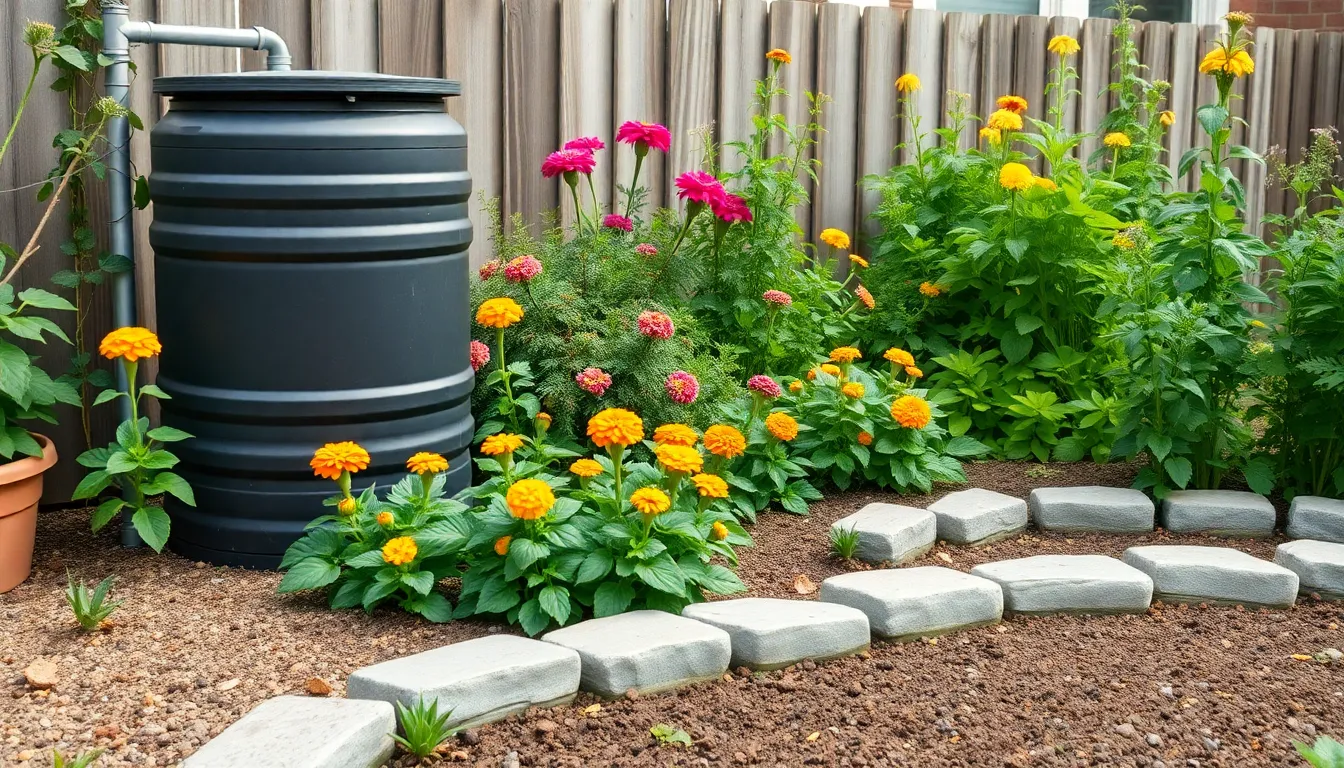
Building on our garden enhancement journey, we’ll explore environmentally conscious methods that protect our planet while creating thriving outdoor spaces. These sustainable practices reduce our environmental footprint and create healthier ecosystems right in our backyards.
Rainwater Collection Methods
Rain gardens and bioswales offer natural answers for collecting and filtering stormwater runoff while conserving precious water resources. We can create these shallow depressions filled with native plants that capture rainwater during storms and slowly release it back into the ground. Positioning these features strategically around our property helps reduce pollution and prevents erosion.
Rain barrels provide another effective way to harvest nature’s gift and reduce our dependence on municipal water supplies. Installing these containers beneath our downspouts allows us to collect hundreds of gallons throughout the growing season. Simple modifications like adding spigots and screens make these systems both functional and user friendly.
Bioswales work particularly well along driveways and pathways where we need to manage water runoff effectively. Native grasses, wildflowers, and shrubs thrive in these areas while filtering contaminants from the water before it reaches our groundwater systems.
Organic Pest Control Answers
Companion planting creates natural pest deterrent systems without relying on harmful chemical pesticides that damage beneficial insects. We can pair marigolds with tomatoes to repel aphids, or plant basil near peppers to ward off spider mites. These strategic partnerships protect our crops while maintaining ecological balance.
Beneficial insects serve as our garden’s natural security force when we provide proper habitats and food sources. Ladybugs, lacewings, and predatory wasps control pest populations more effectively than synthetic chemicals. Creating small brush piles and leaving some areas wild gives these helpful creatures places to overwinter and reproduce.
Biological controls using microorganisms offer targeted answers for exact pest problems without harming beneficial species. Bacillus thuringiensis targets caterpillars that damage our vegetables, while beneficial nematodes control soil dwelling pests like grubs and root weevils.
Eco-Friendly Gardening Materials
Recycled materials transform everyday waste into functional garden features while reducing landfill contributions and material costs. Old tires become raised planters for herbs and vegetables, while broken concrete creates attractive retaining walls and pathway borders. Wine bottles can serve as garden edging or decorative accents throughout our industry design.
Sustainable hardscapes using permeable pavers and natural stone minimize environmental impact while providing durable surfaces for high traffic areas. These materials allow rainwater to infiltrate naturally rather than creating runoff that overwhelms storm systems. Local stone options reduce transportation emissions while connecting our gardens to the surrounding industry.
Organic mulches made from locally sourced materials like wood chips and shredded leaves provide multiple benefits beyond waste reduction. These natural coverings suppress weeds, retain soil moisture, and break down slowly to improve soil structure and fertility over time.
Conclusion
Creating our dream house garden doesn’t have to be overwhelming or expensive. We’ve explored countless possibilities—from vertical container gardens that maximize small spaces to sustainable practices that protect our environment while nurturing thriving plants.
Whether we’re drawn to productive foodscaping that feeds our families or decorative enhancements that create peaceful outdoor sanctuaries, there’s a perfect approach for every lifestyle and budget. The key is starting with what excites us most and building from there.
Our gardens are extensions of our homes and personalities. With the right combination of creativity, planning, and patience, we can transform any outdoor space into a beautiful and functional haven that brings us joy year-round.
Frequently Asked Questions
What are the best container gardening ideas for small spaces?
Container gardening transforms small spaces using vertical planter arrangements, wall-mounted pocket planters, and stacked planter towers. Repurpose household items like old rain boots and vintage colanders as unique planters. Utilize hanging gardens with macrame plant hangers and tiered systems to maximize vertical space and create stunning visual displays on patios and balconies.
How can I create a budget-friendly DIY garden?
Transform discarded shipping pallets into functional growing spaces for herbs and vegetables. Start seeds indoors using seed trays and grow lights. Create homemade compost systems for continuous production. Use affordable materials and simple techniques to build stunning garden features without breaking the bank while maintaining sustainability.
What herbs are easiest to grow indoors?
Easy-to-grow indoor herbs include basil, mint, parsley, cilantro, and chives. These herbs thrive in kitchen environments with proper drainage and moisture management. They provide fresh ingredients year-round and require minimal maintenance, making them perfect for beginners or those with limited gardening experience.
How do I plan seasonal garden activities?
Plan spring planting schedules with early soil preparation and variety selection. Maintain summer routines focusing on water management, mulching, and pest monitoring. Prepare for fall harvests by assessing crops, planning cover crops, implementing frost protection, and collecting seeds for future planting seasons.
What are the best low-maintenance garden plants?
Choose drought-tolerant plants like succulents, native shrubs, and ornamental grasses. Use ground covers to replace traditional grass areas and apply mulch to retain soil moisture. Install self-watering systems or drip irrigation to reduce maintenance frequency while conserving water resources effectively.
How can I create an edible landscape?
Design foodscaping gardens by combining vegetables, herbs, and fruit trees in aesthetically pleasing arrangements. Create themed gardens like salsa gardens with tomatoes, peppers, and herbs. Use square foot gardening methods, integrate fruit trees through espalier systems, and implement companion planting strategies for maximum productivity.
What decorative elements enhance garden appeal?
Install garden pathways using gravel or keystone materials for elegant, low-maintenance walkways. Add outdoor lighting with solar-powered or string lights for ambiance and safety. Incorporate water features like natural pools, fountains, or waterfalls to enhance visual appeal and create tranquil outdoor sanctuaries.
How can I make my garden more sustainable?
Implement rainwater collection using rain barrels, rain gardens, and bioswales to manage stormwater runoff. Use organic pest control through companion planting and beneficial insect attraction. Repurpose recycled materials for garden features and choose organic mulches to minimize environmental impact while supporting healthy ecosystems.

